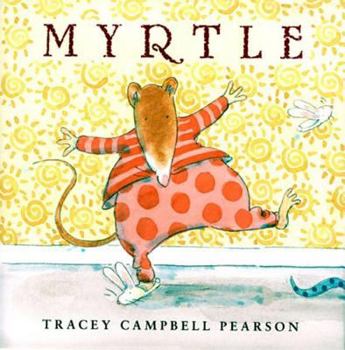Myrtle
How to foil a bully's tactics Myrtle is happy. Her mom loves her. Her dad loves her. Her baby brother loves her. She has a good life - until Frances moves next door. Frances does not love Myrtle, and... This description may be from another edition of this product.
Format:Hardcover
Language:English
ISBN:0374351570
ISBN13:9780374351571
Release Date:March 2004
Publisher:Farrar Straus Giroux
Length:32 Pages
Weight:0.40 lbs.
Dimensions:0.4" x 8.3" x 8.2"
Age Range:3 to 6 years
Grade Range:Preschool to Grade 1
Customer Reviews
2 ratings
The Mouse's Auntie Mame!
Published by Thriftbooks.com User , 19 years ago
Tracey Pearson's "Myrtle" is a lively, colorful book that teaches toddlers and young elementary school kids how to outwit, outplay, and outlast neighborhood bullies. It's a masterful turn by Pearson, who writes and draws with sensitivity and vivacity. Myrtle and her baby brother are happy children who enjoy books, games, and the outdoors, all under the watchful love of their parents. However, this rodent rhapsody is disturbed when Frances moves next door. Pearson gets right to the point: "Frances did not love Myrtle or her baby brother. Frances made mean signs, sang mean songs, and said mean things, Frances was mean." Pearson cleverly mixes the threat with some humor, so that the mean mouse won't frighten readers and listeners too much: "When Myrtle's ball rolled into Frances's yard, Frances kept it for three weeks and two days. Myrtle only got it because her baby brother found it. Frances had covered it with bubble gum, and it stuck to his nose." Frances is both mean and persistent, and she dresses up as a monster, plants rubber snakes, and throws water balloons at the increasingly anxious mouse victims. Here, Pearson's story really departs from cookie cutter formulas entailing wise parents or tricky, funny revenge: She shows that being a victim hurts, Myrtle decides not to go outside at all, and, for some unexplained reason, her parents are unable to comfort her. Pearson shows that parents are not omnipotent and sometimes have to turn to outside help. That is why the loving parents call Aunt Tizzy back from her African safari to help Myrtle. ("Aunt Tizzy dropped her binoculars and caught the first elephant out of the jungle."). If ever there were a lay counselor, it is Aunt Tizzy. She doesn't confront the problem immediately; instead, she focuses on relaxing Myrtle by having fun with her. They "giggled and played"; "they roared and they howled and they yowled" while playing with Tizzy's African masks. Tizzy wears authentic African clothes and masks, beautifully illustrated by Pearson, add even much vitality to the book, but it's a cozy energy, all played out in the intimate safety of Myrtle's large closet. Again, Pearson eschews the obvious. In many books, she and Myrtle would avenge themselves by scaring Frances with the masks. Instead, Tizzy tells Myrtle how she handles "nasty lions" in Africa. She tells them they are rude, "and if they continued, I simply roared back." And sometimes she "would just sing and dance until they were gone" Myrtle comes out of her closet feeling "bigger and stronger," and when Frances confronts Myrtle, her aunt's lessons serve her well. She uses her words ("How rude!"), and then they sing happy, silly songs, drowning out Frances's mean ones. They dance and "squiggle and wiggle," and have so much fun that they forget Frances, who finally comes out of her hiding place and waits "for someone to notice her." (This implied need for attention could be discussed with your young audience.) This very imp
A Must-Have for Your Classroom!
Published by Thriftbooks.com User , 19 years ago
In this fresh and original tale Tracey Campbell Pearson explores a common childhood problem and offers up a deliciously satisfying solution. Myrtle, a mouse, has an idyllic existence. She has a loving mother and father, and a sweet baby brother, a room full of toys, shelves full of books. Life is wonderful . . . until Frances moves next door. Frances is m-e-a-n. Frances dresses up like a monster and scares Myrtle (and her baby brother). She plants fake snakes in Myrtle's yard, steals Myrtle's ball, and generally makes Myrtle's life miserable. When Myrtle begins spending her days in the closet, Myrtle's parents make an emergency call to Aunt Tizzy (who happens to be on safari in Africa ). Aunt Tizzy rushes to the rescue. She spends the day with Myrtle-in the closet-talking and giggling and playing. Myrtle finally tells Aunt Tizzy about mean Frances . Aunt Tizzy tells Myrtle about mean lions in Africa. "Weren't you scared?" asked Myrtle. "Sure, but I wasn't going to let a few nasty lions keep me away from Africa ." Aunt Tizzy said. "What about when they roared mean lion roars?" whispered Myrtle. "I told them to stop being rude, and if they continued, I simply roared back," replied Aunt Tizzy. "Or sometimes," she added, "I would just sing and dance until they were gone." Aunt Tizzy's words have a powerful effect on Myrtle. She leaves the closet, grabs her toys and baby brother, and makes for the back yard. There she and her brother "wiggled and squiggled," laughed and roared, sang silly songs, and . . . ignored Frances. Pearson's bright, colorful watercolor illustrations capture perfectly the unfolding drama, Tizzy's exuberant personality, Myrtle's transformation, and the clever conclusion. Myrtle is a simple yet powerful tale that you will not want to miss. Highly recommended. Reviewed by the Education Oasis Staff.




